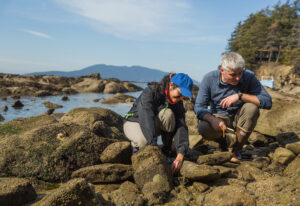Photo courtesy of Marco Hatch, with Lummi students carrying a canoe
Washington Sea Grant Science Communications Fellow, Grace Freeman, a biology graduate student at Western Washington University, recently sat down for an interview with Dr. Marco Hatch, a steering committee member of our Indigenous Aquaculture Collaborative.
In ecology, a community is a group or association of two or more species occupying the same space at the same time. It can refer to many types of living organisms and the complex web of interactions that exists between them. Typically, ecologists limit this definition to non-human species, but Professor Marco Hatch’s Coastal Community and Ecology Lab at Western Washington University (WWU) takes a wider approach. Rather than focusing solely on the plant and animal populations, Professor Hatch and his students work at the intersection of coastal human communities and the ecology of their tidal homes, a place-based approach. “In class we call it resource management, but it’s really about building a reciprocal relationship with the environment,” Hatch says of his work.
Marco Hatch’s work in place-based and community-driven research began when he was an undergraduate at the University of Washington. A member of the Samish Indian Nation himself, Dr. Hatch’s capstone project focused on establishing a historical record of Indigenous fishing in the San Juan Islands using archeological methods and ancient DNA. The traditional technique of the Straights Salish peoples known as reef netting, involves a group of fishermen who suspend a net between two canoes, anchored to rocks placed on the seafloor. The reef net captain watches until salmon swim over the net at which point the net is raised and the salmon are rolled into one of the canoes. Historical ecology and evidence of this traditional technique can be seen in the archeological record as concentrated layers of salmon vertebrae: “it’s like a column of time,” said Hatch. This project strived to reconnect the Coast Salish communities with a vital piece of their history.

Photo courtesy of M. Hatch with student Selid
The Salish Sea Research Center remained focused on community involvement in research. In fact, one of Dr. Hatch’s main goals as the founding director was to support Indigenous students and native environmental science while appealing to national funding opportunities. Currently, the Hatch Lab at WWU focuses on the Coast Salish tradition of clam gardens and how the Indigenous technology could be used for complex resource management today. Building and caring for clam gardens is arduous and requires a lot of people, as Dr Hatch emphasizes. The research conducted by the Hatch Lab and their partners aims to restore coastal tidelands and aid coastal communities in “reclaiming their inherent rights,” he says. Dr. Hatch and his team are specifically interested in the growth of clams within clam gardens. We have repeatedly observed that clams in clam gardens are more abundant and grow faster, but what is the mechanism for this increased growth? In addition to clams, how does the rock wall of a clam garden support other traditional foods such as chitons, sea cucumbers, and limpets? Each of these questions has been addressed by a Hatch Lab Masters student recently.
Looking forward, Dr. Hatch and his collaborators are expanding their attention to include the effects of a changing climate on coastal communities. Building on the historical and geochemical record of clam gardens in the Salish Sea, the lab will be partnering with Misty Peacock, Director of the Salish Sea Research Center at NWIC to assess the effects of harmful algal blooms (HABs) in the Salish Sea. This new project exemplifies the themes present throughout Dr. Hatch’s research: place-based history of aquaculture, reciprocal community-driven environmental management, and support for Indigenous students pursuing education in the face of a changing climate. Another project builds on the latter of these themes by pairing students with Amy Cline, a former NWIC student and Hatch Lab member, with current students in a nested mentorship project partnership with Peacock and NWIC. Dr. Hatch’s work may have started by investigating columns of time in the archeological record, but his legacy of students and programs more closely resembles a web or even, as they say in ecology, a community.
